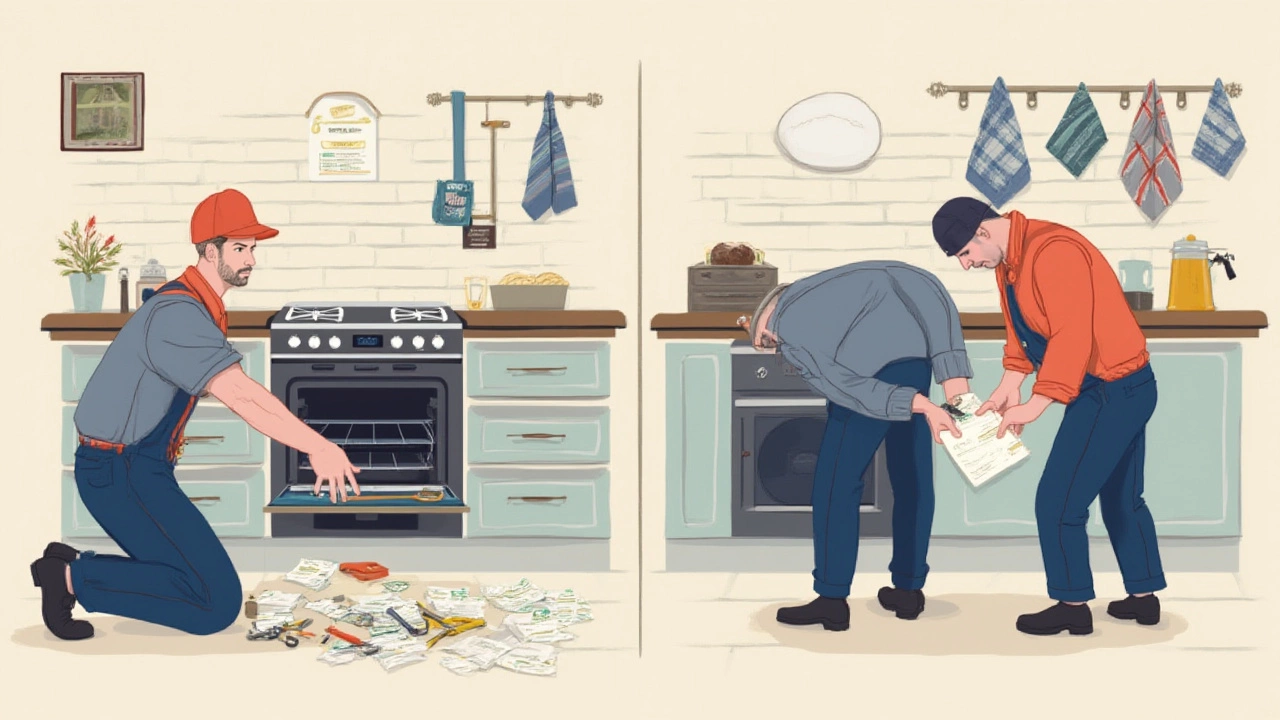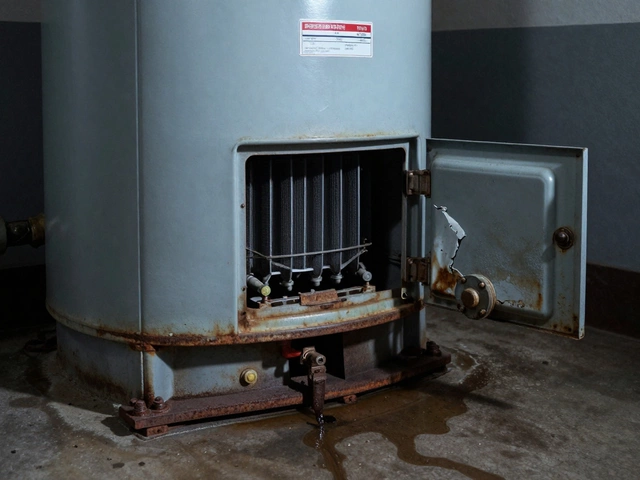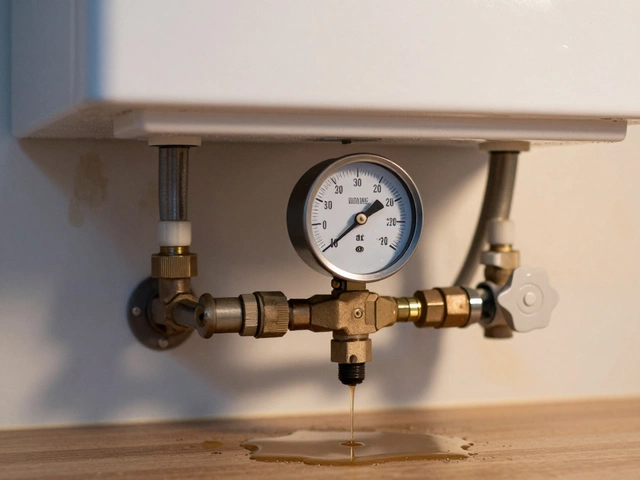It’s dinnertime, you’ve prepped your famous lasagna, and you realize your oven won’t heat up. For a split second, you consider takeout, but then the real question hits: do you call someone to fix the oven, or should you just cut your losses and buy a new one? This decision isn’t always clear, and it’s easy to waste money doing the wrong thing. Let's break down the real numbers, the 'hidden' costs, and the tips the repair shops wish you didn't know.
The True Cost of Repairing an Oven
First off, not all ovens are built the same, and not all repairs are worth your money. You have electric, gas, wall, and even smart ovens in the mix. According to appliance repair data published in January 2025, the average oven repair costs between $150 and $400. That’s a big range, but it mostly depends on what’s wrong.
Let’s get specific. A busted heating element usually runs you about $100 to $250. If your control board goes haywire, you're looking at something closer to $350. Need a new door seal? That can be as cheap as $60 with labor. But things get dicey with older units—finding parts for a ten-year-old oven sometimes costs more than just picking up a new one.
| Repair Type | Average Cost (Parts + Labor) |
|---|---|
| Heating Element Replacement | $125 - $250 |
| Thermostat Replacement | $120 - $300 |
| Control Board Repair | $250 - $400 |
| Door Gasket Replacement | $80 - $175 |
| Igniter Replacement (Gas) | $110 - $225 |
But you can’t just think about the actual cost of fixing. Sometimes repairs mean you’re left without an oven for days—maybe even weeks, if parts are tough to get. If your kitchen is the heart of your home (and if you cook every day), that wait time can feel brutal. Then there’s the hidden cost: maybe the technician fixes your control board, but the heating element is just a few months from burning out. When an oven starts breaking, it’s almost never just one thing. Ever replaced a starter in a car, then had the battery die next?
If you bought a higher-end oven back in 2018, you might find parts are proprietary—made only by the manufacturer and priced like gold. On top of that, most shops charge a minimum diagnostic fee, usually about $75, just to show up and tell you what’s wrong. Some will roll this fee into the repair if you go ahead, but it's still an extra cost if you end up saying, "Nah, never mind."
Some repairs can be DIY if you’re handy, but a word of caution: ovens—especially gas ones—aren’t as forgiving as, say, a wobbly chair. Mess up a gas line or a heating circuit, and you could be looking at a kitchen fire or gas leak. Most folks try to fix the lightbulb or swap a gasket on their own, but leave the rest to a pro unless you know your way around wires and pipes.
The Real Price of Buying a New Oven
Once the repair costs start climbing, the temptation to just buy a new oven kicks in hard. The good news? Appliance retailers know this, and July is typically the second-best month to look for sales—right after Black Friday. Most people see displayed price tags and assume $600 for a basic model or around $1,200 for a good gas or electric oven. But here's where many blow the budget.
The sticker price isn’t the only price. First off, you’ll pay for delivery (often $75 to $100), and most stores charge for haul-away of your old appliance—another $20 to $50. That’s before installation. Electric oven installs are usually straightforward, but gas ovens need safe connection and leak checks from a pro, running you $100 to $200 or more. What's worse, if your kitchen is due for an upgrade (maybe your old oven is 27.5 inches and new ones are standard 30 inches), you could be looking at cabinetry work just to fit the unit.
Here's a real surprise: energy efficiency matters in your wallet. New ovens, especially those with Energy Star ratings, can save up to $40 a year in energy costs compared to a 10-year-old model. Over the lifetime of the oven, that adds up. Factor in new warranties, easier digital features, and fewer repairs in the first few years—that’s real value. But a 2024 survey from Consumer Appliance Trends showed that 54% of new oven owners were surprised by how much they spent after the purchase, mostly on installation and accessory costs like new pans, racks, or smart home compatibility accessories.
- Basic Electric Oven: $600–$1,000
- Basic Gas Oven: $900–$1,500
- Wall Oven: $1,000–$3,000
- Delivery: $75–$100
- Installation (Basic Electric): $100
- Installation (Gas): $150–$250
- Haul-Away: $20–$50
- Permits (if changing gas lines): $50–$200
If you have a budget model now and just want another basic, the switch might not break the bank, especially if you can score a holiday deal. But if you’re eyeing convection, smart features, or dual-fuel, you’ll pay way more up front. On average, replacing a mid-range oven costs $1,200 to $2,000 all-in, installation and extras included, and can be much higher if you go for a high-end brand.

When Does Repair Make Sense?
The golden rule among appliance techs: If the repair costs less than half the price of a new oven and the unit is less than eight years old, repair almost always makes sense. After eight years, you’re in a gray area. Most modern ovens last about 13 to 15 years if cared for. Past that, you’re playing the repair lottery—even a fixed oven can start breaking down repeatedly.
Consider the brand. Some ovens are famous for their longevity. Whirlpool and GE, for example, typically make units that last more than a decade if you keep up with cleaning and don’t slam doors. European brands like Bosch or Smeg tend to have pricier parts, but also better energy efficiency and repair support, so keep that in mind if you own one.
Think about other factors, too. If you’re planning to move in the next year or two, it rarely makes sense to spring for a new oven. Realtors report that unless you’re in a luxury market, a new oven hardly bumps up your home’s value. Sticking with a repair keeps a little more cash in your pocket for the move or your next renovation.
But then, say you have a smart oven, and the repair means losing those WiFi features that originally sold you. Sometimes, fixing an older 'dumbed-down' control board strips away compatibility with things like Google Home or Alexa. If you love those extras, the only long-term fix may be a new oven.
Here's a tip: check your oven's serial number and warranty—you’d be shocked how many brands quietly extended their warranties after pandemic-era supply chain issues. If your model is under a "quiet recall" or extended warranty, you might get a free or low-cost fix. A quick search of the serial + “recall” might save you serious cash.
The availability of parts plays a major role, especially for ovens over ten years old. Manufacturers typically stop producing replacement parts seven to ten years after discontinuing a model. If a key component is no longer available, repairing the oven becomes impossible or requires risky used parts that don’t always last.
DIY repairs are a whole story themselves. Replacing a door gasket, swapping out oven lights, or unclogging vents are doable with a screwdriver and a YouTube guide. But repairs involving gas (igniters, lines, valves) or electricity (control boards, wiring) are best left alone unless you’re trained. Imagine saving $200 on a fix, only to pay $2,000 for a kitchen repair after a bad spark.
Smart Ways to Stretch Your Appliance Dollars
When deciding between repair and replacement, always run the numbers first. Grab a quote for repair—most companies offer free or flat-rate diagnostics—and compare it to the total price (including installation and haul-away) of a new oven. Sounds basic, but people forget about those non-obvious costs.
Don't forget to ask the technician the honest question: “How long do you think this fix will last?” If they hesitate, your oven’s life might not be worth extending. Some honest pros will even tell you when they'd buy a new one for themselves.
Watch for manufacturer rebates and energy incentives. States like California and New York offer rebates for upgrading to energy-efficient appliances, shaving $100 or more off the price tag if you buy a qualifying unit. Check your local power utility—they sometimes offer discounts or rebates for getting rid of old, inefficient appliances. In 2024, the average claim for such rebates was $75, enough to tip the scales toward replacement if your oven is already costing you monthly on the bill.
- Keep your oven clean inside and out. Grease and burnt crumbs can foul up heating elements, fans, and sensors earlier than you’d like.
- Replace door gaskets when you see cracks. Good seals keep heat in, saving energy and preventing hot spots.
- Calibrate your thermostat every six months. A $10 oven thermometer can save you from overbaking (and overspending) by catching failures early.
- Plug your oven into a surge protector if you’re prone to power surges—especially for digital units. You’ll prevent blown circuit boards.
- Act on odd smells and noises. Gas smell? Sparking from inside? Call a pro right away; these are warning signs that can't wait.
If you want my honest take: for ovens less than six years old with a repair under $400, fixing is almost always the move. For anything older than ten years, especially if you’ve had multiple service calls in the past two years, replacement is usually the better bet. There’s nothing worse than putting in $350 only to have it go cold again six months later. People think they’re saving money patching up ancient ovens, but more often they’re just buying a few more months of headaches.
And don’t sleep on timing. The best appliance sales in the U.S. are usually Presidents’ Day, Memorial Day, and the weeks around July 4 and Thanksgiving. Plan your replacement during these times for the best chance at discounts, free delivery, or bonus installation deals.
Here's a last bit of advice… Listen to your gut. If you find yourself dreading another repair or fighting with unreliable temp controls every week, there’s a reason. Ovens aren’t just big metal boxes—they’re the centerpiece of every family meal, every late-night pizza craving, every Christmas turkey. Buying smart, knowing when to fix, and being proactive with maintenance can keep your kitchen (and your wallet) happy for years.
So, fix or buy? This time, you’ve got the numbers and the inside scoop to figure out what really makes sense for your kitchen and your budget.






